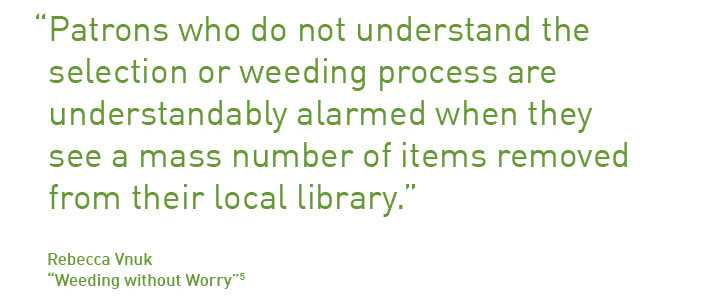| By Thorndike Press Staff |
What comes to mind when you think of weeding? Bending over on the ground. Tugging on stubborn weeds around your peonies. Getting dirt under your fingernails, even when using gloves. Feeling the hot sun on your neck. But afterward, you’re left with a beautiful flower bed and a sense of accomplishment.
Now, shift your focus to weeding your library’s collection.
For many of us, this type of weeding is even more daunting. However, weeding your library’s shelves is just as important as weeding your flower beds. And it can bring you even greater rewards.
Why Is Weeding Important?
New books are published daily. As much as we would all love to have libraries filled with every book that exists, it just isn’t feasible. We have to make room for new stories and updated knowledge on our shelves.
Weeding, also known as deselection, not only makes space for new books in our collections but also helps increase the circulation of titles that remain. When you remove outdated titles from overstuffed shelves, you make it easier for patrons to browse your collection and discover both new and old titles that appeal to them.

How Should Your Library Approach Weeding?
1. Establish Weeding Parameters
Creating weeding guidelines will help your library staff understand what to weed and what to keep. Consider factors like the age of the material, accuracy of the information, last circulation date, number of circulations, condition, if your system has multiple copies, or if the book is part of a series.2
For detailed guidance, consult CREW: A Weeding Manual for Modern Libraries, developed by the Texas State Library and Archives Commission. You’ll not only find tips to weed responsibly, but you can also follow weeding guidelines for specific categories like children’s books, periodicals, and eBooks.
2. Weed on a Regular Basis
When you have a regular system in place to review and remove materials from your library, maintaining your collection is much easier. Develop a process to continually review materials by establishing times to weed smaller sections of your collection throughout the year.
According to the CREW manual, “You should weed about the same amount as you are adding to the collection unless you are in a developing mode.”3 Weeding alongside collection development ensures your library’s offerings remain balanced.

3. Inform Your Community about Weeding
If your library weeds on a regular basis, your patrons may not notice the changes in your collection. However, if you undergo a large-scale weeding process that leaves lots of empty space on your shelves, alarm bells may sound from concerned community members.
Keep your community informed about your library’s weeding process, especially if they will notice changes. You can post an update on your website, email patrons, or share info on social media about what weeding is, why it’s necessary for your library, and what your patrons can expect during the process.
Also, always make sure your staff is well-versed in explaining weeding to patrons to answer questions about materials that have been removed from circulation.
4. Welcome Feedback before Weeding
Giving library staff, faculty, and community members the chance to weigh in about whether or not materials should be removed can help guide your weeding process.
Some faculty and staff members may have reasons for recommending the library keep specific titles. Consider providing a list of materials you plan to remove before officially weeding them from your shelves to give staff and patrons the opportunity to share their feedback. This will make your staff and community feel more involved in the weeding process and diminish the chances of someone being upset well after a title is removed.
5. Find Homes for Weeded Books
Weeding gets a bad rap because it makes people picture books in dumpsters—or, even worse, burning books. When it comes to finding new homes for weeded books, though, your library has lots of options.
Consider holding a community book sale or selling weeded books online. You can also explore options for donating or recycling books and other materials locally. Find more ideas for selling or repurposing weeded books from the North Dakota State Library.6
What’s Next after Weeding?
Just like you can expect new growth in your garden after you free your plants from the weeds, weeding your library’s shelves provides more room for exciting new reads.
When you’re ready to shelve new titles after weeding, consider bringing your community a more accessible reading option. Large print is an equitable format that can help everyone in your community enjoy reading, from those who need a break from digital devices to those who can’t stay engaged with standard print.
Take advantage of our limited-time Weeding Sale until September 30, 2023. Use code WEEDING23 to save 30% on over 1,700 Thorndike Press large print titles published from 2019 through May 2023—plus, get free shipping.
You can build a more appealing, inclusive collection by adding large print books. Start your library’s weeding process and browse Weeding Sale titles today.
Notes:
- Chant, Ian. “The Art of Weeding | Collection Management,” Library Journal, June 23, 2015.
- North Dakota State Library. “Collection Development and Maintenance: Weeding,” LibGuides.
- Larson, Jeanette. “CREW: A Weeding Manual for Modern Libraries,” Texas State Library and Archives Commission, 2012.
- Allen, Melissa. “Weed ’Em and Reap: The Art of Weeding to Avoid Criticism,” Library Media Connection, May/June 2010.
- Vnuk, Rebecca. “Weeding without Worry,” American Libraries, May 2, 2016.
- North Dakota State Library.


